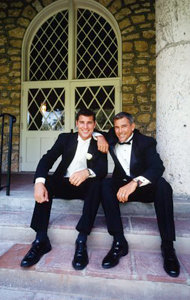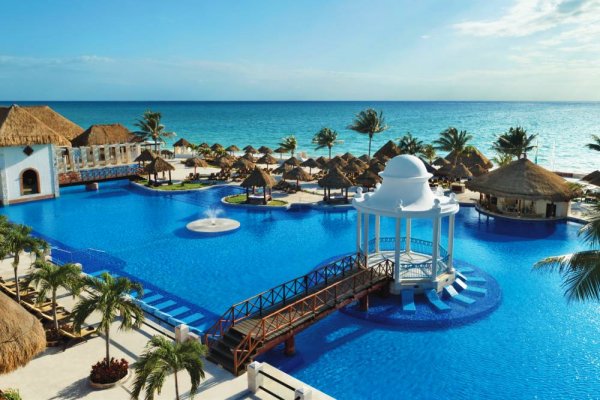Does your groom know a notch from a peak? A four-in-hand from a bow tie? Once he knows what styles suit him best, he'll know exactly what to ask for.
Suit Styles
 Tuxedo: A single- or double-breasted jacket with matching trousers (usually with a side satin stripe). Tuxedos are the preferred choice for formal or semiformal evening weddings, and are now a popular choice for afternoon weddings as well.
Tuxedo: A single- or double-breasted jacket with matching trousers (usually with a side satin stripe). Tuxedos are the preferred choice for formal or semiformal evening weddings, and are now a popular choice for afternoon weddings as well.
Tuxedos come in a variety of fabrics and colors. Black is certainly the most popular; however this season dark brown and navy are an alternative option. White and ivory tuxedos remain appropriate for many occasions, especially for spring and summer weddings.
Solid tuxedo fabrics are the most popular, but striped fabrics as well as other patterns, are also in vogue. Most tuxedos are made of worsted wool and wool blends. Destination weddings have also popularized lighter fabric tuxedos, which are now easy to find.
Tuxedos come with a variety of lapel styles:
Notch: A triangular indentation is cut where the lapel joins the collar.
Peak: A broad v-shaped lapel that points up and out just below the collar line.
Shawl: A smooth, rounded lapel.
Dinner Suit:A white or ivory dinner jacket, generally with a shawl lapel, is worn with black formal trousers. This is an ideal option for formal and semiformal evening weddings in the spring and summer months (or year-round in warmer climates). This is also a great choice for destination weddings.
White Tie and Tails: This is the classic choice for the ultra-formal evening wedding. The tailcoat jacket is short in the front with two long back tails. A white pique (a waffle-textured fabric in cotton or cotton blend) front wing-collar shirt, tie and vest make up the rest of this ensemble. Tailcoats can be worn for formal daytime or evening weddings in black, gray, navy or burgundy with matching ties and cummerbunds.
Cutaway and Stroller: Also known as a morning suit, this style is appropriate for formal daytime weddings (11 am to 4 pm). The groom wears the cutaway/morning coat, which tapers from the front waist button to a long, wide back tail. Accessories include a wing-collar shirt with an ascot and a coordinating vest. Attendants wear a stroller/walking coat, which is cut slightly longer than a suit jacket, and is worn with a lay-down collar shirt and a four-in-hand tie. Both jackets, in either black or gray, are worn with matching striped trousers.
Shirt Styles
There are many different shirt styles and colors, with or without pleats, and with or without ruffles. While white is still the clear winner, black, burgundy and a variety of pastel colors are also popular. Grooms can also choose from a variety of striped shirts.
Traditionally formal shirts have been fabricated in cotton and cotton blends, however now there are several microfiber shirts available that are both comfortable and wrinkle-free.
The classic tuxedo shirt is white with buttons or stud closures. It may or may not have French cuffs and usually has 1/4" or 1/2" pleats on either side of the buttons or studs. It comes in a variety of collars.
The type of collar is what distinguishes one shirt from another and each collar style usually comes in several different shirt styles.
Wing Collar: Similar to a band collar, but with two turned-down points in front that give it the appearance of a spread collar.
Band Collar: A collar that stands up around the neck and above the buttons. The entire length of the tie surrounding the neck is visible on this type of collar.
Spread collar: Similar to a man's standard button-front shirt, it folds over and around the neck with a wide division between points in the front. The new European look in formal shirts boasts a very wide spread collar.
.jpg) Accessories
Accessories
Accessories allow you to put your personal stamp on the your wedding. The grooms' and groomsmen's accessories are often coordinated to match the bridal party's fashions, with the groom sometimes choosing a slightly different look than his groomsmen.
![]() Bow tie: This is the original classic tie for formal attire. A short tie shaped like a bow that can be worn with a wing or a spread collar. A shirt's wing collar can either be tucked behind the bow tie or worn facing out over the tie. Most bow ties are pre-tied and adjust to fit all neck sizes. They are available in a wide variety of widths, colors and patterns to match or coordinate with the vest or cummerbund. Bow ties that can be tied by hand are also available for a slightly more sophisticated look (be sure you practice before your wedding day).
Bow tie: This is the original classic tie for formal attire. A short tie shaped like a bow that can be worn with a wing or a spread collar. A shirt's wing collar can either be tucked behind the bow tie or worn facing out over the tie. Most bow ties are pre-tied and adjust to fit all neck sizes. They are available in a wide variety of widths, colors and patterns to match or coordinate with the vest or cummerbund. Bow ties that can be tied by hand are also available for a slightly more sophisticated look (be sure you practice before your wedding day).
Four-in-hand tie: This is the traditional name for the type of necktie most men wear to work and it is becoming increasingly popular for formal attire. Like the bows, these ties come in a wide variety of styles and are usually pre-tied with adjustable necks.
Euro-tie: A long, knotted square-bottom necktie worn with a wing or spread-collar shirt.
Ascot: A wide necktie (almost like a scarf) that is looped over and held in place beneath the chin with a tie tack or stickpin. Worn with a wing-collar shirt and the daytime wedding cutaway jacket.
Shar-pei: A wrinkled-knot four-in-hand necktie.
Cravat:A long, pleated band or scarf worn around the neck.
Cummerbund: A silk or satin sash worn at the waist, covering the trousers" waistband. A cummerbund should be worn with the pleats facing up (remember it was once called a "crumb catcher"). Generally the cummerbund matches the tie's color and fabric.
Vest: The vest is today's most popular choice and is worn in place of a cummerbund to cover the trouser waistband. They come in a variety of button stances, with lapels or without. Some are adjustable at the neck and waist with an open back, while others have a fully covered back. If you think you might remove your jacket during the reception, you should opt for a full-back vest.
Vests are worn with a matching or coordinating tie (bow, four-in-hand or euro). They are available in a wide variety of fabrics and colors. The most popular choices are neutrals (blacks, grays, beiges, and whites) or colors that accent the bridesmaid's gowns.
Pocket Square: A small pocket handkerchief tucked into the left breast pocket worn by groomsmen instead of a boutonniere.
Cuff links: Decorative jewelry used to close French cuffs.
Studs: Jewelry similar to the cuff links that are used to close the front of a formal tuxedo shirt, which traditionally does not have buttons down the front. Studs usually come in sets of three or four.
Suspenders: Also called braces. Two bands worn over the shoulders to support the trousers. Worn with a cummerbund (but never with a vest). They can coordinate, in color or pattern, with the cummerbund. They are available with a clip or leather fastener.
Formal Shoes: Tuxedo shoes generally have a very high sheen, and are often made of patent leather. Shoes may be solid black, white, ivory or two-toned. Black shoes should be worn with black tuxedos, white with white, etc. Two-toned are generally worn with black or striped tuxedos. Alternative colored shoes are available to coordinate with brown or navy tuxedos.
If a shoe requires laces, they should be strung in a horizontal fashion. Tuxedo shoes should be worn with matching dress socks.



